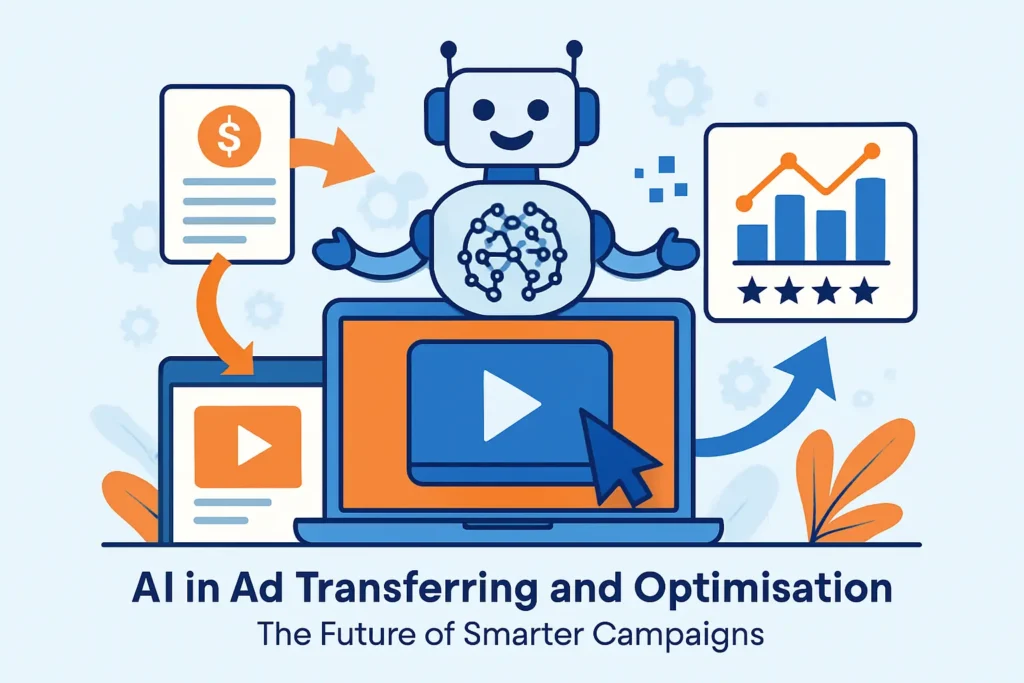AI in Ad Transferring and Optimisation: The Future of Smarter Campaigns

In the fast-paced world of digital marketing, time is not just money , it’s opportunity. Marketers today tricking multiple platforms, diverse ad formats, and ever-changing audience preferences and interests. But one of the largest drains on efficiency has always been the manual effort involved in transferring ads from one channel to another, and the endless change to optimise performance.
Artificial Intelligence (AI) is rewriting that story. By automating ad transferring and supercharging optimisation, AI is helping brands run smarter, faster, and more personalised campaigns without sacrificing creativity.
- Final Thoughts
- What is AI in Ad Transferring?
Traditionally, moving an ad from Facebook to Google, LinkedIn, or Instagram meant hours of manual resizing, reformatting, and copy adjustments. AI changes this by:
• Auto-adaptation of creatives – Instantly adjusting image and video dimensions for different platforms.
• Format-aware content transformation – Tweaking copy length, tone, and CTA placement for each channel’s audience behaviour.
• Bulk cross-platform publishing – Deploying ads simultaneously across platforms with one click.
• Smart asset tagging – Automatically identifying key visuals and messages to fit targeting criteria on each platform.
This automation means marketers can spend less time on logistics and more time on creative storytelling. - How AI Optimises Ads in Real Time
Every digital marketing freelancer Kerala should aware about it. AI shifts the balance towards science by analysing performance data in real time and making decisions at speeds humans simply can’t match.
AI-powered optimisation includes:
• Automated A/B testing – Running multiple ad variations and reallocating budget to the highest-performing creatives.
• Predictive bidding – Adjusting bids dynamically to target the most valuable impressions.
• Audience micro-segmentation – Finding and targeting niche audience clusters with high conversion potential.
• Creative performance analysis – Learning which visuals, headlines, and formats drive the best engagement.
• Contextual optimisation – Timing ads to align with trending topics or seasonal demand spikes. - Why This Matters for Marketers
For businesses and marketers, AI-driven ad transferring and optimisation delivers three major benefits:
• Speed – Campaigns that once took days to adapt now go live in minutes.
• Efficiency – Budgets are allocated intelligently, reducing waste.
• Scalability – Multiple campaigns can be managed and optimised simultaneously without adding manpower.
This is especially game-changing for small and medium businesses, or independent marketers, who can now compete with bigger budgets by leveraging AI’s speed and precision. - Tools can be used as a digital marketing freelancer Kerala.
A few platforms already excel in this space:
• Google Ads Smart Campaigns – AI-driven targeting and bid optimisation.
• Meta Advantage+ Creative – Automatically adapts and tests ad formats.
• AdCreative.ai – AI-generated creatives optimised for conversion.
• Albert AI – Autonomous campaign management and optimisation.
• Celtra – assess creative asset production across platforms. - The Human + AI Equation
While AI can handle the heavy lifting of transferring and optimising advertisements, but it doesn’t replace the human presence. Creativity, empathy, and brand voice still need a marketer’s vision. AI simply ensures that vision is executed at scale, in the right place, at the right time, and to the right audience.
In short, AI is the backstage crew that makes sure the spotlight hits at the perfect moment — leaving marketers free to focus on the performance.
Final Thoughts
It’s the new standard for efficient, data-driven marketing. Brands that embrace it can launch faster, adapt better, and connect more meaningfully with audiences. Those that don’t may find themselves stuck doing the manual work while their competitors move light-years ahead.
The future is clear: AI does not take over marketing , but it boosts it.